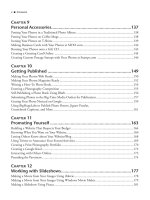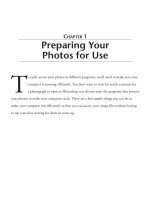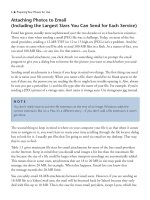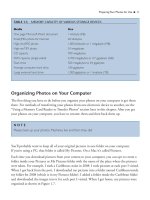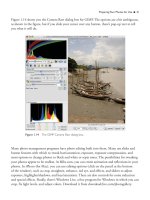101 QUICK AND EASY SECRETS FOR USING YOUR DIGITAL PHOTOGRAPHS- P16 pps
Bạn đang xem bản rút gọn của tài liệu. Xem và tải ngay bản đầy đủ của tài liệu tại đây (247.36 KB, 5 trang )
CHAPTER 4
Preparing Your
Photos for Use
T
here’s a good possibility that you have thousands of images on your computer
(maybe even tens of thousands) and external hard drive(s), and you don’t know
where to start when it comes to using them. Rest assured, if you read this book,
you’ll be off to a good start toward putting your photos to good use. One of the first things
you should do in terms of using your photos is to print some of the best ones. Prints give
you a good idea of what your images really look like. With today’s advanced printing
technology, ink-jet prints that you make with your printer can last generations. There are
a number of things you have to do in order to prepare your photos for printing. In this
chapter you’ll learn some of them, as well as the ins and outs of obtaining the best printer
money can buy and of setting up for the printing process.
Printing Anywhere with a Portable Printer
Since Polaroid film (the film you put into a Polaroid camera that develops instantly after you
take a picture) has all but bitten the dust, something had to give in terms of getting your images
printed on demand.
It’s not only the printer you’ll want to consider if you’re in the market for having your pictures
printed quickly. The costs of paper and ink are surely going to be issues with respect to these
machines. But if you have to have prints to hand out to your friends and family right away, with
a portable printer, you know that your photos won’t end up stored in your computer for who
knows how long.
There are several portable printers on the market—some good and some bad. Here’s the scoop.
Dell’s Wasabi is a no-ink (called Zink) device that uses paper with dye crystals in it that Wasabi
warms up to make a picture. The device weighs only eight ounces. Wasabi uses Bluetooth,
which means it operates wirelessly. It takes 55 seconds to print a picture and can only hold
12 pieces of photo paper at a time.
The drawback to this device is that the pictures are only 2×3 inches. The paper (which comes
with sticky backing) comes in packs of 24 and will cost you about 50 cents per piece. The
nice thing about it is you don’t have to buy ink. Polaroid makes a similar model that uses Zink
technology called the Pogo.
Epson’s PictureMate Dash (see Figure 4.1) can be carried around as you would a small lunchbox.
It weighs a little more than five pounds. You can get a Bluetooth adapter to make the device
work wirelessly. You can also purchase a rechargeable battery. The device is reasonably priced
(about $150), and the paper and ink (about $40 for ink and the paper pack for 150 glossy
photos) are rather reasonable, too.
HP’s Photosmart 375 is a three-pounder that can read your digital camera’s memory card to print
photos. (You can also use the USB cable that comes with your camera.) There’s a rechargeable
battery you can get for the device. Supplies can be had for about $33 and include an HP 95
series cartridge and 100 sheets of borderless 4×6-inch glossy HP Premium Photo Paper.
Getting the Best Printer for the Price
The first thing to keep in mind if you’re going to display prints in your photo albums or hang
them on your walls is that inkjet printers are the best option for photography. You might think
that ink smears and won’t look good in a couple of years. Nothing is further from the truth.
It’s the paper and ink combination that, with today’s technology, can create an archival (lasts
more than a hundred years), smearless print.
62 ■ Preparing Your Photos for Use
You can get some pretty decent printers in
the $200 to $300 range from a number of
different companies. Mind you, these are
not professional printers, but they don’t do
a bad job either, sometimes besting prints
you get at Walmart.
One of the main differences between the
two printers listed in this section and the
pro printers is that the former print directly
from a camera, something a pro wouldn’t
want to do because there is not enough
control over what happens to the photo
before it’s printed. More about pro printers
in the next section, “Printing with the
Printer the Pros Use.”
Epson’s Artisan 700 (see Figure 4.2) is an
all-in-one printer that does it all: prints,
copies, and scans photos.
You can connect this printer to your laptop or camera (if it is PictBridge enabled, a feature that
many cameras have) with USB cable or Bluetooth. Or you can take out your camera’s memory
card and insert it into a matching memory card slot (each card can only fit into one-size slot) on
the printer. You can even print from a USB flash drive. The printer lets you crop so that only
part of your picture is printed. This printer is fast, printing a 4×6 image in about 10 seconds.
The one drawback for this printer is the ink cost. It needs six different
cartridges. At more than $12 a pop, that can get pretty pricey.
With HP’s Photosmart B8550, you can
connect the printer to your camera (again,
PictBridge enabled), and it has USB flash
drive and memory card slots for direct
printing from these devices. This printer
has five ink cartridges, which you can get
for $12 or so. The nice thing about the
8550 is that you can make extra-large prints
(13×19 inches). The 8550 is a bit slower
than the Artisan, though, printing a 4×6
photo in 18 seconds.
Preparing Your Photos for Use ■ 63
Figure 4.1 A PictureMate Dash printer from Epson.
Figure 4.2 Epson’s Artisan 700 makes archival prints.
Printing with the Printer the Pros Use
To get pristine images like you see in a gallery, you’ll have to use a pro printer with Photoshop,
Photoshop Elements, or another professional image processing program. The two most popular
manufacturers that make pro printers are Epson and Hewlett-Packard. Most professional
photographers who print their own work use what is called a workflow in the image processing
program. The workflow involves letting Photoshop (rather than the printer) determine the
colors for the final print.
One of the first things you’ll want to decide before you buy a pro printer is how big you want
your photo. Pro printer selection is made by the width of the paper rolls the machine holds.
(Machines also take single sheets.) Epson has professional models that hold 13 inches (Epson
Stylus R2880), 17 inches (Epson Stylus Pro 3800, 4880), 24 inches (Epson Stylus Pro 7880,
7900), and 44 inches (Epson Stylus Pro 9880, 9900). Prices range from about $700 to $6,000.
See Figure 4.3.
HP also has professional models that hold 13
inches (HP Photosmart Pro B8800, B9180),
24 inches (HP Designjet Z3200, Z3200ps
24-in), and 44 inches (HP Designjet Z3200,
Z3200ps 44-in). Prices range from about
$630 to $6,800.
Choosing the Right Paper for Making Prints
There is a wide array of papers from which to choose before you start printing your photos.
The ones you choose will depend upon what you are going to do with your photograph.
Most photographers would agree that archival acid-free paper is best for printing because the
paper can last for several generations.
64 ■ Preparing Your Photos for Use
Figure 4.3 The Epson Stylus Pro holds 24-inch-wide paper rolls.
Photo paper varies from manufacturer to manufacturer, so you are best off using the paper the
printer manufacturer recommends. I’ve seen many inconsistencies in printing when paper other
than what the manufacturer recommends is used.
Epson, HP, Kodak, and Canon offer a variety of papers. The paper comes in rolls or in packages
that contain single sheets. Generally, rolls are available for printers that are more than 13 inches wide.
In terms of printing for photography, Epson is the choice of many photographers who print on
their own. One of the most common papers for professionals is Premium Glossy Photo paper,
which comes in rolls and sheets. Photographers who sell high-end photographs sometimes print
on textured fine art papers (made of 100-percent rag cotton) and/or velvet paper.
Just to get an idea of the range of papers you can use, the Epson R2880 can print on the following:
plain paper, Epson Bright White Paper, Presentation Paper Matte, Premium Presentation Paper
Matte, Premium Presentation Paper Matte Double-Sided, Ultra Premium Presentation Paper
Matte, Photo Paper Glossy, Premium Photo Paper Glossy, Premium Photo Paper Semi-Gloss,
Ultra Premium Photo Paper Luster, Exhibition Fiber Paper, Watercolor Paper Radiant White,
Velvet Fine Art Paper, UltraSmooth Fine Art Paper, Premium Canvas Satin, Premium Canvas
Matte, and PremierArt Matte Scrapbook Photo Paper.
Most photo paper manufacturers offer some type of canvas paper. You can create a painting-like
photo using canvas (Epson offers a couple of different kinds) and an image that has been
manipulated with a painting effects software program. Figure 4.4 shows a photograph printed
on canvas. (Seascapes take well to this type of media.)
Preparing Your Photos for Use ■ 65
Figure 4.4 Photograph printed on canvas.


